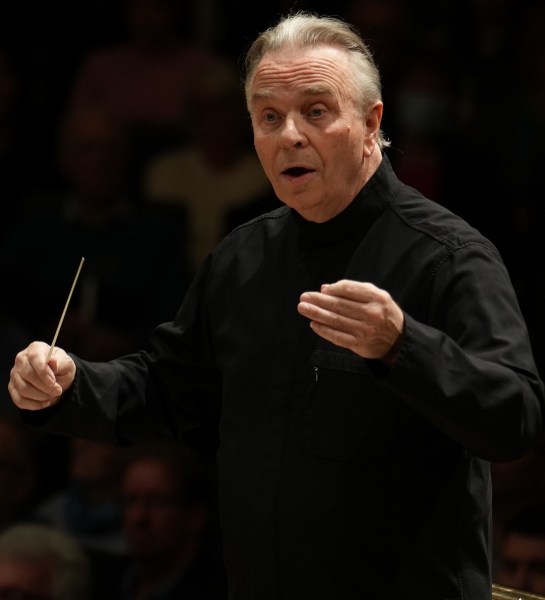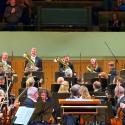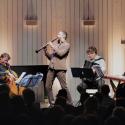Nicola Benedetti and Sir Mark Elder are both in the enviable position of being able to take audiences with them into music territory that might scare some away. So it was a gratifyingly near-capacity house that heard Szymanowski’s Second Violin Concerto last night as – on the first occasion they have worked together – they presented it to the Hallé audience.
It’s long been a favourite of gifted solo violinists, because of its combination of folk-style energy and lyricism (and the cadenza movement, which was written by its first soloist Pawel Kochański and divides the work roughly in two, is a tour de force in its own right).
Elder is an expert concerto partner, and there was never any problem of audibility for Benedetti. The orchestral tutti began with the quiet intensity and sweet expressiveness that have become the hallmark of the Hallé strings in the Elder era: the solo playing was contrastingly eloquent and passionate. There are two big climactic orchestral passages in the work’s first section, before the cadenza, each finely crafted to make its effect, the first is a slow-burn affair but was the more powerful for its initial restraint; the second faster and resounding.
That cadenza itself, in Benedetti’s hands, was more than just virtuoso fireworks. She found beauty in it and brought her imagination to the technically demanding show-off passages. And in the remainder of the piece, which is marked by renewed alternation of character between the solo part (albeit now with a more lively, “folk” feel to it at times) and those of the orchestra’s sound, she sold every note to her listeners. Elder brought tender and thoughtful insights to the performance, and in the closing section, when Szymanowski enlivens things considerably and even adds a touch of Hollywood-style glamour, rhythms were springing and the ending effective.
 The programme began with Respighi’s Fountains of Rome tone poem. It made an interesting foil to 1930s Szymanowski – earlier in date (it’s from the Great War era) but with the same awareness of subtle orchestral effects. Its first bars opened the concert with beautifully blended woodwind playing (Respighi’s scoring for piccolo and bassoon together needs something very different from, say, Stravinsky’s). The Hallé’s wind principals shone in turn, and the strings, led by Roberto Ruisi, were pure and clear. Respighi’s vivid vision of “The Trevi Fountain at Midday”, for full orchestra including deep rumbles from the organ, is a different thing altogether, but this wide spectrum of sound avoided harshness, and led to a return to the delicacy of the opening for “The Villa Medici Fountain at Sunset”, a tapestry that weaves cor anglais, piano and celesta into its texture – all of them delightfully clear. Elder had his percussionist strike the gentle Angelus bell from on high at the back of the choir seating area of the hall, and if there was a brief moment of hesitation in the strings it didn’t detract from the magic of the moment.
The programme began with Respighi’s Fountains of Rome tone poem. It made an interesting foil to 1930s Szymanowski – earlier in date (it’s from the Great War era) but with the same awareness of subtle orchestral effects. Its first bars opened the concert with beautifully blended woodwind playing (Respighi’s scoring for piccolo and bassoon together needs something very different from, say, Stravinsky’s). The Hallé’s wind principals shone in turn, and the strings, led by Roberto Ruisi, were pure and clear. Respighi’s vivid vision of “The Trevi Fountain at Midday”, for full orchestra including deep rumbles from the organ, is a different thing altogether, but this wide spectrum of sound avoided harshness, and led to a return to the delicacy of the opening for “The Villa Medici Fountain at Sunset”, a tapestry that weaves cor anglais, piano and celesta into its texture – all of them delightfully clear. Elder had his percussionist strike the gentle Angelus bell from on high at the back of the choir seating area of the hall, and if there was a brief moment of hesitation in the strings it didn’t detract from the magic of the moment.
Brahms’s Symphony No. 2, on the other hand, was a little less sonically attractive, wonderful music though it is. Elder (pictured above) follows the now-fashionable policy of reduced string numbers for Brahms symphonies, with proportions somewhat different from those we hear at other times: relative strength in the middle voices (violas and celli) but not too many basses; he also separates the trumpets from the trombones spatially. It’s all aimed at transparency, and you can appreciate the more choral type of voice balance it brings, allowing much of Brahms’s carefully woven counterpoint to shine through. And the sense of mystery and tenderness in the opening (repeated as per score) was lovely, as were the rhythmic alertness and precision of the syncopated chords that come in the following pages.
But I did miss the whole-hearted resonance that bigger forces and a little less restraint might have allowed: it’s often gentle music, more in the style of a serenade than a traditional symphony, but it can speak the language of passion, too. A very lively presto tempo in the third movement brought a contrast, and the finale had its moments: not hanging around much, even for the marking of largamente, but making a theatrical big finish – the fortissimo blast of the trombones unleashed at last.















Add comment